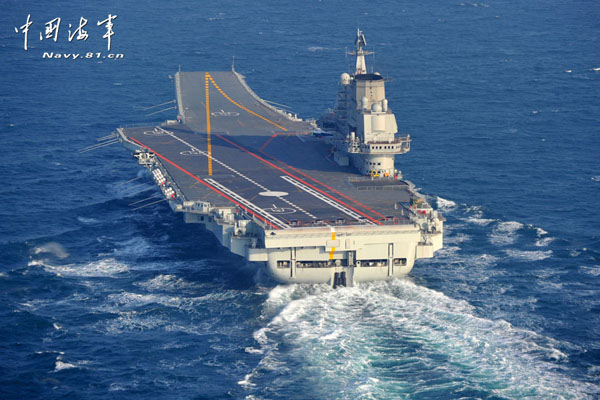The Chinese navy and its global counterparts
- By Zhang Lulu
 0 Comment(s)
0 Comment(s) Print
Print E-mail China.org.cn, February 16, 2014
E-mail China.org.cn, February 16, 2014
|
|
| The nation's first aircraft carrier, the Liaoning. [photo / navy.81.cn] |
The past 2013 has been a fruitful year for the Chinese navy. The nation's first aircraft carrier, the Liaoning, successfully carried out a training mission in the South China Sea last November; the latest Type 052D-class destroyer completed a sea trial in September; 17 new warships have been reportedly commissioned in 2013 alone; and the three fleets, namely the North Sea Fleet, the East Sea Fleet, and the South Sea Fleet conducted six training exercises in the west Pacific region.
The list of successes goes on, but China is only one of the world powers that have been building up maritime strength.
The United States' shipbuilding plan
The U.S. Department of the Navy released in last April its proposed US$155.8 billion budget for the fiscal year 2014, according to a report by the U.S. Navy. Though there was a slight reduction of US$4.2 billion from 2012, the Navy maintained its budget requests to procure eight new warships annually.
The U.S. Navy will allocate US$ 15.1 billion each year to build new warships from 2013 to 2017, according to its 30-year (FY 2013-2042) shipbuilding plan submitted to the Congress in March, 2012.
Besides shipbuilding, the U.S. Navy also saw several ships perform extraordinary feats in the past year.
The Northrop Grumman X-47B, dubbed the "U.S. Navy's smartest jet," landed successfully on the USS George H.W. Bush last July, making it the first drone to land on an aircraft carrier. The USS Zumwalt (DDG-1000), the largest destroyer ever built by the United States, begun service last October. A month later, the super-carrier Gerald R. Ford-class aircraft carrier also entered the water.
Japan reinforces its power to the southwest
Japan approved the budget plan of its Ministry of Defense for the fiscal year 2014 last December, which came to a staggering US$45.86 billion -- the 2.2 percent year-on-year increase is Japan's largest in nearly two decades.
The majority of the budget will be spent on Japan's defense force to the southwest as highlighted in its budget plan.
One of the priorities lies in Japan's maritime power building, including maritime reconnaissance, navy force building, island defense and amphibious abilities.
Japan will enhance its surveillance ability, including the warning and surveillance ability of the Boeing E767 and the procurement of four new P1 maritime patrol aircraft.
At least 15.5 billion yen (about US$151 million) will be spent on the deployment of a coastal observation unit to Japan's Yonaguni Island, which lies just 108 kilometers from the east coast of Taiwan and 148 kilometers from the Diaoyu (Senkaku) Islands, so as to keep a better watch on the Chinese Navy.
Besides, the helicopter carrier JDS Izumo (DDH-183), Japan's largest naval vessel since the WWII, was launched last August, which is able to land the F-35 jet fighter.
Japan will also buy four F-35 jet fighters, one destroyer, 16 missile launching vehicle, and one Patriot missile system, among other equipment, under its FY 2014 budget plan.
India's Vikrant
India's Vikrant-class aircraft carrier was launched last August, making it the fifth nation to build an aircraft carrier in the world (after the United States, Russia, Britain and France).
The US$5 billion ship will be able to carry 30 aircraft, including the Mikoyan MiG-29K, the Kamov Ka-31 and some light jet fighters.
India's defense spending will amount to a huge US$ 112 billion from 2010 to 2016, as estimated by the consulting firm KPMG.
The Russian Navy in the Arctic
Russia's First Deputy Defense Minister Arkady Bakhin announced last September that Russia has reasserted its presence in the Arctic region, when its heavy nuclear missile cruiser Peter the Great, accompanied by several support vessels, completed its cruise in the region.
One of the priorities of the Russian navy in 2014 is to enhance its reconnaissance and training in the Arctic. The Navy will carry out navigation and diving in the area and develop a series of ice-breaking cruisers to protect its interests there.
Russia's President Vladimir Putin said during a senior meeting last December that the nation needed to beef up its military presence in the Arctic. He called for Russia to set up new forces and military units in the region in 2014, which may cost billions of rubles.
Besides the North Pole, Russia is also attempting to expand its maritime nuclear power. For instance, the Alexander Nevsky (K-550), a nuclear ballistic missile submarine, entered service last December, while the Yury Dolgorukiy (K-535), the first of the Borei-class, was already in service in the beginning of 2013.






